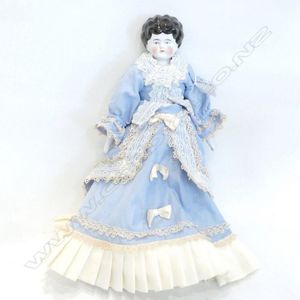Victorian Porcelain Doll in Blue Dress on Stand
Victorian porcelain doll 'Blue dress on Stand', height 37.5 cm, porcelain head / hands and feet painted face / hair and shoes cloth body / arms and legs. Blue satin and white lace dress with broderie anglaise petticoat and pantaloons.
You must be a subscriber, and be logged in to view price and dealer details.
Subscribe Now to view actual auction price for this item
When you subscribe, you have the option of setting the currency in which to display prices to $Au, $US, $NZ or Stg.
This item has been sold, and the description, image and price are for reference purposes only.
- Broderie Anglaise - Broderie anglaise was popular in the 19th century and has been used to decorate clothing and home textiles since then. Broderie anglaise, also known as English embroidery, is a decorative needlework technique that involves creating cutwork designs on fabric using a combination of embroidery and lace-making techniques. The designs typically feature small, intricate holes cut into the fabric and then embellished with embroidery stitches.
This type of embroidery is usually made on lightweight fabrics such as cotton, linen or batiste, and is characterized by its delicate and lacy appearance. Broderie anglaise is often used to embellish clothing, linens, and other household items such as tablecloths, napkins, and doilies. The designs can be geometric, floral or figurative and it's mostly used for decorative items such as clothing, home decor and accessories. - Victorian Period - The Victorian period of furniture and decorative arts design covers the reign of Queen Victoria from 1837 to 1901. There was not one dominant style of furniture in the Victorian period. Designers used and modified many historical styles such as Gothic, Tudor, Elizabethan, English Rococo, Neoclassical and others, although use of some styles, such as English Rococo and Gothic tended to dominate the furniture manufacture of the period.
The Victorian period was preceded by the Regency and William IV periods, and followed by the Edwardian period, named for Edward VII (1841 ? 1910) who was King of the United Kingdom and the British Dominions and Emperor of India for the brief period from 1901 until his death in 1910.
This item has been included into following indexes:
